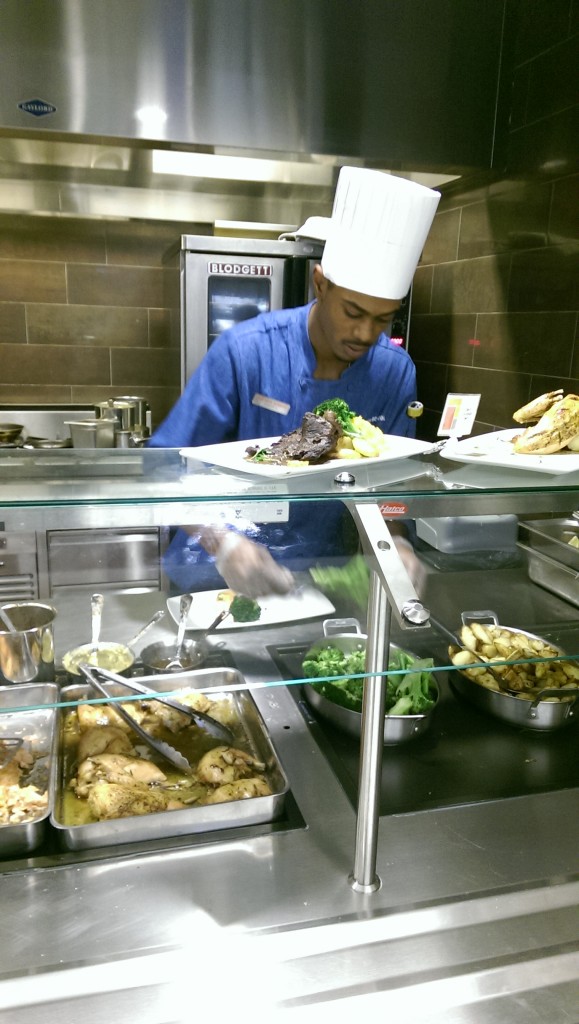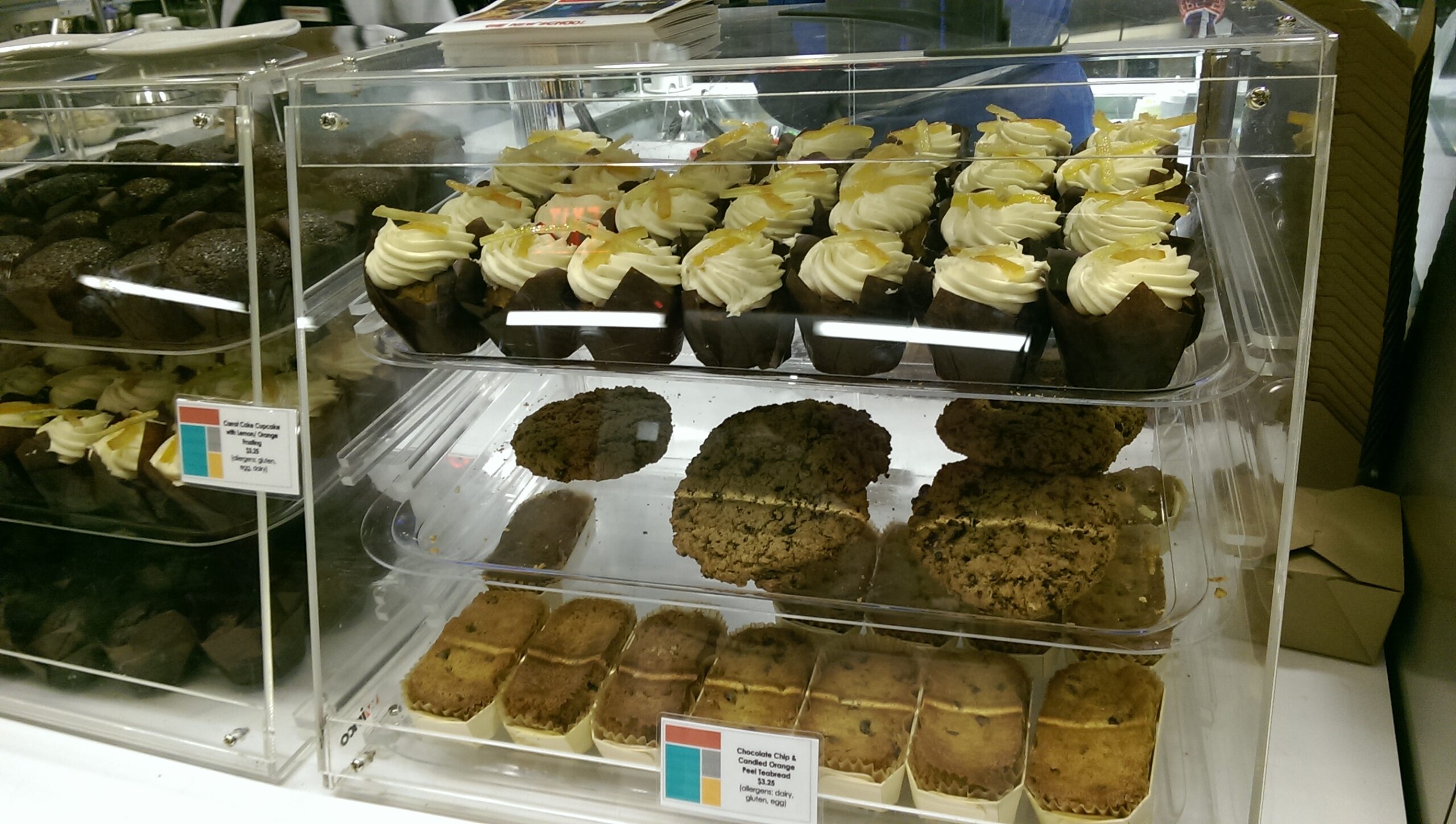With the opening of the new University Center, the Real Food Group, a student organization focused on changing food practices at The New School, is making progress slowly but surely toward their goal of having mostly “real” food available to students on The New School campus. As a result of the Real Food Group’s recent partnership with food service provider Chartwells Dining Services, the University Center Café currently offers a large amount of organic and local food, including all grass-fed and local meat, local vegetables, and pastries made in-house.
The University Center is LEED-certified (under the Leadership in Energy & Environmental Design rating system), because of its implementation of strategies to keep the building’s carbon footprint down. Twenty percent of the building material is recycled and is designed to utilize as much natural light as possible. Economizing on transportation, using natural ingredients whenever possible, and serving Real Food in the UC Café, play an equal part in maintaining the building’s overall sustainability.

Food is considered to be “real” if its ingredients are locally grown, ecologically sound, fair, or humane, according to Joe Anderson, a junior at Lang and a member of the Real Food Group. If something gets a check in one of these categories, it becomes Class B; two or more checks, and it’s stamped Class A.
“During high school, I got into more consciously eating and caring about what I was eating,” Joe Anderson told The Free Press. During this time, he also started thinking about the food industry, how to change what was wrong with it, and his own “impact on the system and the world as a consumer.” Two years ago, Anderson chose to join Real Food to further pursue his interest in food activism.
When the restaurant-style cafeteria University Café opened in January, there was a noticeable increase in pricing. For example, the “Grilled Salmon with Wild Rice and Lemon Aioli” costs $8.99, whereas the hot food last semester had a self-serve deli layout, with a unit price at $7.21 per pound, averaging out to roughly $5 for a full meal.
“I would say it is a little bit expensive,” said Joseph, a Fashion Design major at Parsons. “Last semester, we could choose dishes and amount. But now it’s not so flexible and I am not so satisfied.”
While the price of the food seems high for some students, it is considerably lower than what the school pays to obtain the ingredients, according to The New School’s sustainability food coordinator, Corinna Borden.
“With our food cost, a lot of the ingredients are actually a gift to the community,” Borden told The Free Press. “So the school is absorbing a lot of the difference [from the market value.]”
Real Food is working with two local food distributors, Hudson Valley Food Network and J. Kings, to find the right farms to work with at the cafeteria. These groups are connected to many local farms, mostly in Upstate NY and Greater New England. The distributors try to stay roughly 250 miles from New York, close enough to meet local food standards, according to the Real Food Challenge organization, which works with colleges across the country to make real food available to students.

The next step for the Real Food Group is for the school to sign the Campus Commitment with Real Food Challenge. Signing the Campus Commitment would put the school on track for having at least 20 percent real food on campus within five years, but Real Food hopes to achieve something closer to 80 percent.
“There are a lot of compromises that need to be done between a system that is based on feeding people and making money, and another one where the goal of the school is to implement the Real Food Challenge and not based on making money,” New School Pastry chef Cyril Chaminade said. “It’s based on culture, ideology.”
Linus is a Literary Studies major at Lang. He enjoys seeing dope music shows and cooking dope ass meals in his spare time. He hails from Seattle, WA and left there to get away from the perpetual grey weather and become a full time New Yorker instead. He plans to write fiction as a career (knock on wood) and travel a lot.








I all the time used to read article in news papers
but now as I am a user of internet therefore from now I am using net for content, thanks
to web.
Hello there! I could have sworn I’ve been to your blog before but after going through some of the posts I realized it’s new to me.
Anyways, I’m definitely happy I stumbled upon it and I’ll
be book-marking it and checking back regularly!
Peculiar article, exactly what I was looking
for.
Hello there! I could have sworn I’ve been to this blog before but after browsing through some of the post I
realized it’s new to me. Nonetheless, I’m definitely glad I found it
and I’ll be bookmarking and checking back frequently!
Definitely consider that that you stated. Your favourite reason seemed to be at the web the easiest factor to keep in mind of.
I say to you, I definitely get irked while folks think about concerns that they
plainly do not know about. You managed to hit the nail
upon the top and defined out the entire thing with no need side effect , folks could take a
signal. Will likely be again to get more. Thank
you
Hi, Matthew. It is a gift to the community in that the price the pay for the ingredients is much higher that what we pay to purchase them in the cafe. Our price is much lower than what it would be if sold outside of the new school, in other businesses around the area.
I understand your point about the price of tuition going towards maintaining local food sources, but that’s a systemic issue. I think everyone would appreciate if that issue was addressed in any facet.
how is the school giving a “gift” by “absorbing a lot of the difference {of the market value}? The difference between paying the cost of the meal at the register vs paying for it in our tuition checks is that, when payment comes from tuition, all those students who choose to opt out of eating at the new school cafeteria are paying for the food anyways.